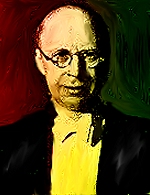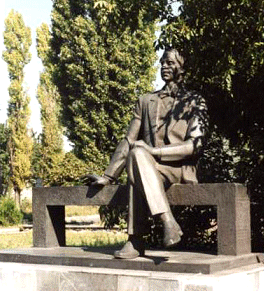|
Xtend
 Listen
Listen
 Period
Period
 Country
Country
 Quotation
Quotation
 Projects
Projects
 Dictionary
Dictionary
 Finders
Finders
|
Born: 23 April
1891, Sontsovka, Russia
Died: 5 March 1953, Moscow, Russia
 Prokofiev,
Sergei Prokofiev,
Sergei
Among Russia's prominent composers in the 20th century. Studied with Rimsky-Korsakov
prominent composers in the 20th century. Studied with Rimsky-Korsakov and other teachers, and was a gifted pianist. As early as in his first
pieces (the Piano Concerto No. 1), his tendency
toward bold harmonies and sophisticated rhythmic games that provoked harsh
criticism, was evident. On the other hand, he also had a tendency for Classic
and other teachers, and was a gifted pianist. As early as in his first
pieces (the Piano Concerto No. 1), his tendency
toward bold harmonies and sophisticated rhythmic games that provoked harsh
criticism, was evident. On the other hand, he also had a tendency for Classic structures and tonality
structures and tonality ,
and the combination between innovative and classical is visible in his
work from that time, such as the Symphony No. 1,
"The Classic", in which he wrote clean, brilliant music
- Haydn-style ,
and the combination between innovative and classical is visible in his
work from that time, such as the Symphony No. 1,
"The Classic", in which he wrote clean, brilliant music
- Haydn-style . .
 He
left Russia in 1918, after the October Revolution, and lived for some time
in the US He
left Russia in 1918, after the October Revolution, and lived for some time
in the US and in Paris
and in Paris .
During his wandering around Europe, he was
influenced by Stravinsky's .
During his wandering around Europe, he was
influenced by Stravinsky's "Rite of the Spring", and wrote
music for the same ballet as him (for Sergei Diaghilev),
music that put him on the cutting edge of modern music.
"Rite of the Spring", and wrote
music for the same ballet as him (for Sergei Diaghilev),
music that put him on the cutting edge of modern music.
 Being
in America, he composed an opera called "The
Love for Three Oranges", but when he returned to the Soviet
Union in 1934, he gradually changed his bold
musical style and mellowed it, for the government's satisfaction.
Since then, he wrote music for different plays and films (including the
sound score for "Alexander Nevsky",
by Soviet cinema genius Sergei Eisenstein);
particularly loved is "Peter and the Wolf" Being
in America, he composed an opera called "The
Love for Three Oranges", but when he returned to the Soviet
Union in 1934, he gradually changed his bold
musical style and mellowed it, for the government's satisfaction.
Since then, he wrote music for different plays and films (including the
sound score for "Alexander Nevsky",
by Soviet cinema genius Sergei Eisenstein);
particularly loved is "Peter and the Wolf" which he wrote for an orchestra and a narrator, describing a Russian folk
children's educational tale. Each figure in the story is portrayed by an
instrument, in the Wagner
which he wrote for an orchestra and a narrator, describing a Russian folk
children's educational tale. Each figure in the story is portrayed by an
instrument, in the Wagner -like
"guiding theme" (leitmotif -like
"guiding theme" (leitmotif )
technique. )
technique.
 He
died in 1953, on the same day as Stalin and
never enjoyed the relative relaxation in musical censorship that then took
place. He
died in 1953, on the same day as Stalin and
never enjoyed the relative relaxation in musical censorship that then took
place.


Prokofiev on the WWW
 Sites
Sites
|
 Audio
Audio
|
 Video
Video
|
 Images
Images
|
 MIDI
MIDI
|
|
Description
He played

He Lived in the
 Twentieth Century
Twentieth Century
In
 Russia
Russia
And now on the WWW
 Home Page
Home Page
|